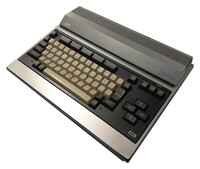JVC MSX HC-7 GB
| Home > Browse Our Collection > Computers > JVC / Victor > JVC MSX HC-7 GB |
|
This was one of the models brought to market as part of the MSX Project, it has a slightly unusual design compared to other MSX machines. The cartridge slots are on the rear right, and the right side of the machine, it has 64K of RAM and a 32K ROM. It is the Victor HC-7 for the UK market. The super imposing feature however has been removed. This allowed text to be overlayed onto a video picture. The MSX was an attempt to make a single computer standard, and was manufactured mainly by Japanese companies. Toshiba, Canon, Sony, Pioneer, Sharp, Hitachi, JVC and a good few others. The origin of the name is in dispute, most accept it stands for Microsoft Extended. Spectravideo in the US and Philips in Europe also produced versions of the machine. Many Japanese companies were trying to get into the home micro market, and Kazuhiko Nishi, Vice President of Microsoft and Ascii, thought it was a good opportunity to standardise the home market. There were features of the machines that had to be adhered to, such as the four cursor keys, and was originally built around the architecture of the Spectravideo SV-328 computer, and was comprised of off the shelf parts, such as the Z80 CPU and TMS9918 graphics chip. Most used full travel keyboard, but companies such as Casio produced much smaller machines that had a chiclet keyboard. Memory wise MSX machines could have 16K, 48K, or most commonly like the HX-10 64K. Some early Casio machines had only 8K of RAM, but this could be expanded via cartridges or an expansion unit that the computer plugged in on top of. By the time the MSX arrived in Europe in late 1985, several companies such as Commodore, Amstrad, Acorn and Sinclair had been enjoying great success, and the MSX machines offered little more than those already on the market, and cost a great deal more. In Japan, software would come on Cartridge or floppy disk, and although these were available in Europe, the most common way of loading into the machine was via tape in this territory. The Toshiba HX-10 was even packaged with a tape deck. Needing tape software, the games companies in the UK and elsewhere were more likely to convert games from the Spectrum, as the architecture with the Z80 was similar, but due to the slower video access, the games were seen as little more than less speedy Spectrum games. The JVC does have a good range of connections on the machine, the power switch is on the left hand side, and the PSU is internal, on the left side are two Atari style joystick ports, and also a centronics interface port, and the rear has the Expansion bus, video out and audio out, the RF and the DIN plug for the cassette lead, unlike most MSX machines that are composite video out, this model has an RGB Scart socket. The standard did not go nearly as worldwide as intended, having only a small impact in the UK and France, doing better in the Netherlands and Spain, and also selling well in Japan and S Korea. If it had released a couple of years earlier throughout the world, and produced cheaper, it could have been a real contender. Manufacturer: JVC Comment on This Page JVC MSX HC-7 GB Manuals:
Magazines RELATED to JVC MSX HC-7 GB in our Library
Other Systems Related To JVC MSX HC-7 GB:
This exhibit has a reference ID of CH66852. Please quote this reference ID in any communication with the Centre for Computing History. |
Click on the Image(s) For Detail
|















